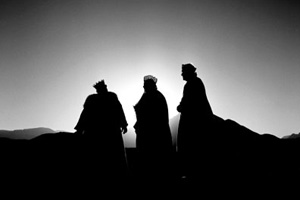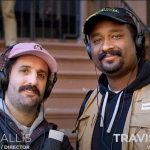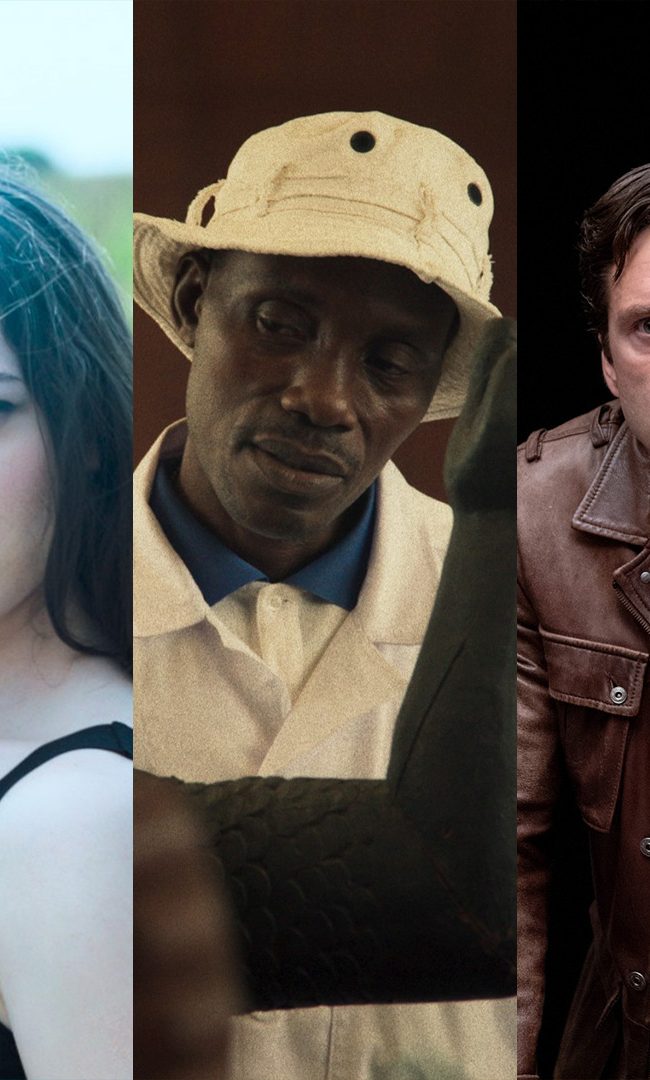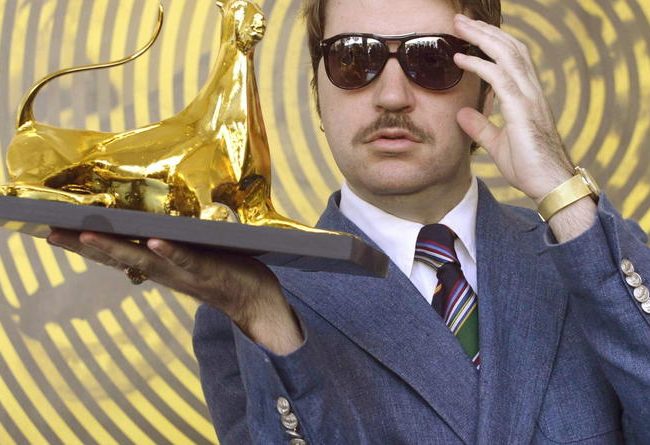BIRDSONG
(Birdsong gets a limited one-week run at Anthology Film Archives beginning Wednesday, February 25, 2009. The feature-length documentary about the making of the film, Waiting For Sancho, screens on Saturday, February 28, and Sunday, March 1, at 5pm.)
In the early moments of Catalan director Albert Serra’s Birdsong, it appears that one just bought a ticket for a Pretentious Art Film. Black-and-white photography, long static takes, little-to-no dialogue, three robe-and-crown wearing magi wandering through a desolate landscape… yes, there can be no doubt about it: Birdsong is a PAF. Yet it isn’t long before a tiny crack is spotted in the façade of pretension. After the magi have gone for a swim (shot from below with gorgeous Malickian reverie), they are now on shore, walking across the sand, away from the frame, in order to reunite with their sandals. The slowest moving one is also the most rotund, and at one point he stops. But it’s not just because he’s tired. It’s that the ground is hot and the shells are hurting his feet. At this moment, I had to suppress an urge to grin, thinking that I was playing an inappropriate game of modern association. But moments later, when this pudgy fellow catches up with the others, looks up at them, and does a goofy roll down the hill, the façade shattered and I saw the light: Birdsong was, in fact, a spiritually bumbling comedy!
In the same way that Jim Jarmusch used humor, beauty, and spirituality to deliver a defiantly original revisionist Western with Dead Man, Serra does the same thing with Birdsong; yet here, Serra is out to revise an older, more deeply mythical tale. Birdsong follows the Three Kings on their journey to Bethlehem to bless the newborn baby Jesus, but from the way Serra portrays it, this wasn’t the spiritually transcendent act the Bible made it out to be. While Serra’s magi aren’t booze-addled philanderers, they are much goofier than we expect them to be (played by non-actors Lluis Carbo, Lluis Serrat Batlle, and Lluis Serrat Masanellas with a hilarious—at times jarringly so—naturalism). The film’s poetic silences are broken not to hear these men pray, but to hear them bicker about which direction they’re heading, if clouds could support their weight, and to tell each other to move over when they find themselves sandwiched in a pile of branches for a daily nap. No, these aren’t the Three Kings I learned about in Sunday School, and all I can say is thank God for that (pun very intended).
 Another major revision to this tale—in a Biblical and cinematic sense—is how Serra chooses to build his narrative (some might call it an anti-narrative). He removes the climactic heroism of the magi’s journey and their subsequent bestowing of gifts. At the film’s 40-minute mark (out of just over 90), we abandon the kings completely in order to meet Mary and Joseph (played by Serra’s righthand woman, producer Monste Triola, and Cinema Scope film critic Mark Peranson). Mary seems to be more preoccupied with a baby lamb than with her own newborn, who is nowhere to be found (or maybe he just sleeps all the time—yet another reason why Jesus was the Best Baby Ever!). But after nearly 20 minutes of watching Mary and Joseph sit around doing a whole lot of absolutely nothing, we finally catch a glimpse of Jesus, who Mary is holding as the magi arrive. Saying nothing, they present their gifts and bow to the ground, as the film’s only music swells (Pau Casal’s “El Cant Dels Ocells”). When the music ends, the moment ends. The magi take a mud bath, sit around in silence with Mary and Joseph, and head off into the distance, like construction workers at the end of a long day. An anti-climax if ever there was one, but in the most invigorating of ways.
Another major revision to this tale—in a Biblical and cinematic sense—is how Serra chooses to build his narrative (some might call it an anti-narrative). He removes the climactic heroism of the magi’s journey and their subsequent bestowing of gifts. At the film’s 40-minute mark (out of just over 90), we abandon the kings completely in order to meet Mary and Joseph (played by Serra’s righthand woman, producer Monste Triola, and Cinema Scope film critic Mark Peranson). Mary seems to be more preoccupied with a baby lamb than with her own newborn, who is nowhere to be found (or maybe he just sleeps all the time—yet another reason why Jesus was the Best Baby Ever!). But after nearly 20 minutes of watching Mary and Joseph sit around doing a whole lot of absolutely nothing, we finally catch a glimpse of Jesus, who Mary is holding as the magi arrive. Saying nothing, they present their gifts and bow to the ground, as the film’s only music swells (Pau Casal’s “El Cant Dels Ocells”). When the music ends, the moment ends. The magi take a mud bath, sit around in silence with Mary and Joseph, and head off into the distance, like construction workers at the end of a long day. An anti-climax if ever there was one, but in the most invigorating of ways.
At the same time, for all of Serra’s efforts to avoid sensationalizing or over-dramatizing his material, he nonetheless suffuses Birdsong with a spiritual gravity that makes it more than just an artistic spin on an irreverent comedy. Jimmy Gimferrer and Neus Olle’s divine cinematography (in both senses of the word) consistently dwarfs the magi as they wander through these magical landscapes (the film was shot in the Canary Islands). Within these daunting wide frames, God and the angels are always watching. And while, to the magi, their journey seems like just another weary, thankless task, Serra uses his camera to reinforce the nobility and import of their cause.
Birdsong more than superficially calls to mind the work of Bela Tarr or Gus Van Sant’s Gerry. Yet as long as Serra’s shots seem, they are nowhere near as long as those in Gerry or Satantango. With the exception of one glorious eight-and-a-half-minute take. What is certain to annoy some viewers when they realize Serra isn’t going to cut until his figures have disappeared from the frame in the seemingly endless distance, is guaranteed to delight others who display patience. For the shot’s eventual punchline is an experimental and playful optical illusion that will have heads spinning as if we too have been wandering in the sun-scorched desert for days.
Perhaps as a trade-off for appearing in the film, Peranson shot an accompanying feature-length documentary about the making of Birdsong. In Waiting For Sancho, Serra reveals that his motivation for making this film was first and foremost a desire to follow these three non-actors around—not to tell the Nativity story, not to make any broad statement about religion, nothing like that. He was clearly amused by their interactions, and this is where Waiting For Sancho proves to be a great companion piece (although a making of documentary should never be longer than the film it is documenting, except for in exceptionally rare cases). If it seems like there is a drunken wooziness to the performances that these men give, that’s because they were drunk on wine just about the whole time! Rather than simply sitting these modern figures at a table and filming them as they shot the shit, Serra came up with a truly original way to put them on screen. In doing so, he has produced a dreamy, hypnotic, and spiritual art comedy that can dissected by a more theoretically inclined viewer, or embraced more lightheartedly by a comically attuned one.
— Michael Tully











